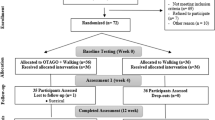Abstract
Summary
The present study was conducted to determine the effect of 5-month exercise program on the prevention of falls in the elderly. The exercise training, which consisted of calisthenics, body balance training, muscle power training, and walking ability training 3 days/week improved the indices of the flexibility, body balance, muscle power, and walking ability and reduced the incidence of falls compared with non-exercise controls. The present study showed the beneficial effect of the exercise program aimed at improving flexibility, body balance, muscle power, and walking ability in preventing falls in the elderly.
Introduction
The present study was conducted to determine the effect of exercise on the prevention of falls in the elderly.
Methods
Sixty-eight elderly ambulatory volunteers were randomly divided into two groups: the exercise and control groups. The daily exercise, which consisted of calisthenics, body balance training (tandem standing, tandem gait, and unipedal standing), muscle power training (chair-rising training), and walking ability training (stepping), were performed 3 days/week only in the exercise group. No exercise was performed in the control group.
Results
After the 5-month exercise program, the indices of the flexibility, body balance, muscle power, and walking ability significantly improved in the exercise group compared with the control group. The incidence of falls was significantly lower in the exercise group than in the control group (0.0% vs. 12.1%, P = 0.0363). The exercise program was safe and well tolerated in the elderly.
Conclusions
The present study showed the beneficial effect of the exercise program aimed at improving flexibility, body balance, muscle power, and walking ability in preventing falls in the elderly.




Similar content being viewed by others
References
Runge M, Rehfeld G, Resnicek E (2001) Balance training and exercise in geriatric patients. J Musculoskel Neuronal Interact 1:61–65
Asmussen E (1980) Aging and exercise. Environ Physiol 3:419–428
Runge M, Hunter G (2006) Determinants of musculoskeletal frailty and the risk of falls in old age. J Musculoskel Neuronal Interact 6:167–173
Frost HM (1997) Defining osteopenias and osteoporosis: another view (with insights from a new paradigm). Bone 20:385–191
Schiessl H, Frost HM, Jee WSS (1998) Estrogen and bone-muscle strength and mass relationship. Bone 22:1–6
Gardner MM, Robertson MC, Campbell AJ (2000) Exercise in preventing falls and fall related injuries in older people: a review of randomized controlled trials. Br J Sports Med 34:7–17
Gillespie LD, Gillespie WJ, Robertson MC, Lamb SE, Cumming RG, Rowe BH (2001) Interventions for preventing falls in elderly people. Cochrane Database Syst Rev 3: CD000340
Lane JM, Nydick M (1999) Osteoporosis: current modes of prevention and treatment. J Am Acad Orthop Surg 7:19–31
Wolf SL, Barnhart HX, Kutner NG, McNeely E, Coogler C, Xu T (1996) Reducing frailty and falls in older persons: an investigation of Tai Chi and computerized balance training. J Am Geriatr Soc 44:489–497
Podsiadlo D, Richardson S (1991) The timed “up & go:” A test of basic functional mobility for frail elderly persons. J Am Geriatr Soc 39:142–148
Allen SH (1994) Exercise considerations for postmenopausal women with osteoporosis. Arthritis Care Res 7:205–214
Feskanich D, Willett W, Colditz G (2002) Walking and leisure-time activity and risk of hip fracture in postmenopausal women. JAMA 288:2300–2306
Hoshino K, Beppu M, Ishii S, Masuda T, Hibino Y, Oyake Y, Aoki H, Sudou K, Iida Y (2002) The gait analysis of the elderly at the fall prevention exercise class. J Physical Medicine 13:113–117 (in Japanese)
Acknowledgments
We would like to thank Mr. Fusamitsu Inui, Mr. Toshihiro Yamaguchi, and other members of the Tokyo Branch of Banyu Co. Ltd., Tokyo, Japan for their assistance in the preparation of the trial.
Conflicts of interest
None.
Author information
Authors and Affiliations
Corresponding author
Rights and permissions
About this article
Cite this article
Iwamoto, J., Suzuki, H., Tanaka, K. et al. Preventative effect of exercise against falls in the elderly: a randomized controlled trial. Osteoporos Int 20, 1233–1240 (2009). https://doi.org/10.1007/s00198-008-0794-9
Received:
Accepted:
Published:
Issue Date:
DOI: https://doi.org/10.1007/s00198-008-0794-9




